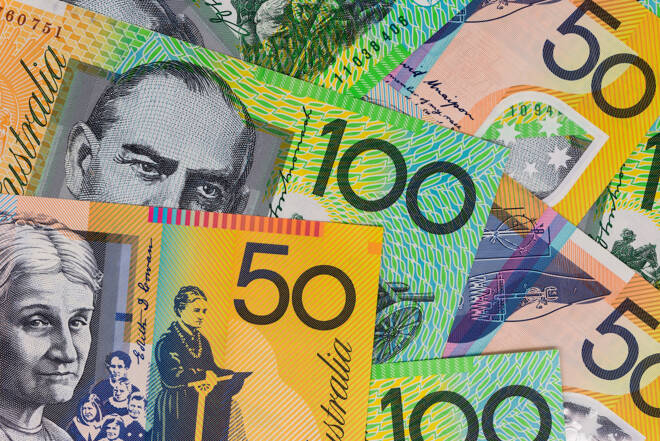Advertisement
Advertisement
AUD to USD Forecast: Consumer Sentiment Unexpectedly Falls in January
By:
Westpac's January Consumer Sentiment Index fell by 1.3% to 81.0 in January, impacting the Aussie dollar's outlook.
Highlights
- The AUD/USD declined by 0.31% on Monday, ending the session at $0.66605.
- Australian labor market data impacted buyer demand for the Aussie dollar ahead of official employment numbers on Thursday.
- On Tuesday, Australian consumer confidence numbers and geopolitical risk warrant investor attention ahead of the US session.
Monday Overview of the AUD/USD
The AUD/USD declined by 0.31% on Monday. Following a 0.09% loss on Friday, the Australian dollar ended the session at $0.66605. The Australian dollar rose to a high of $0.67045 before falling to a low of $0.66502.
Australian Consumer Confidence
On Tuesday, consumer confidence was in the spotlight. Westpac Consumer Sentiment figures for January garnered investor interest after the recent surge in retail sales.
The Westpac Consumer Confidence Index decreased by 1.3% to 81.0 in January. Economists forecast the Consumer Confidence Index to rise by 0.5% to 82.5.
Consumer confidence trends are significant for the RBA. Downward trends in consumer confidence could suggest weaker consumer spending. Negative consumer spending trends could dampen demand-driven inflation.
In December, the RBA considered raising interest rates to tame inflation. A negative outlook for consumer spending could allow the RBA to begin discussions about rate cuts. However, labor market conditions remain a consideration.
Weaker labor market conditions could impact wage growth and disposable income. Downward trends in disposable income would curb consumer spending and dampen demand-driven inflation.
Beyond the numbers, stimulus chatter from Beijing and geopolitical tensions also need consideration.
US Economic Calendar: NY Empire State Manufacturing Index and the Fed in Focus
On Tuesday, the NY Empire State Manufacturing Index will draw investor interest. The manufacturing sector accounts for less than 30% of the US economy. However, the markets are betting on a soft landing.
Better-than-expected numbers would support the market expectations of a soft landing. Barring an unexpected slide in the Index, the report is unlikely to give a reason for the markets to adjust bets on a March Fed rate cut.
Economists forecast the NY Empire State Manufacturing Index to rise from -14.5 to -5.0 in January.
Beyond the numbers, investors must consider Fed speakers. FOMC member Christopher Waller is on the calendar to speak. Reactions to the recent inflation reports would move the dial. Calls for a higher-for-longer Fed rate hike to tame inflation would impact buyer demand for the AUD/USD.
Short-Term Forecast
Near-term trends for the AUD/USD remain hinged on Australian labor market data, US retail sales, and Fed chatter. Weaker Australian labor market conditions would support bets on an H2 2024 RBA rate cut. However, a surge in US retail sales and hawkish Fed chatter could force the markets to reduce bets on a March Fed rate cut.
AUD/USD Price Action
Daily Chart
The AUD/USD held above the 50-day and 200-day EMAs, sending bullish price signals.
An AUD/USD break above the Monday high of $0.67045 would support a move toward the $0.67286 resistance level.
On Tuesday, Australian consumer confidence, Beijing, and geopolitics will be focal points before the US session.
However, a fall through the 50-day EMA would bring the $0.66162 support level and 200-day EMA into play.
A 14-period Daily RSI reading of 44.21 suggests an AUD/USD drop to the $0.66162 support level before entering oversold territory (typically above 70 on the RSI scale).
4-Hourly Chart
The AUD/USD remained below the 50-day and 200-day EMAs, sending bearish near-term price signals.
An AUD/USD break above the 200-day EMA would support a move to the 50-day EMA and the $0.67286 resistance level.
However, a drop below the $0.66500 handle would give the bears a run at the $0.66162 support level.
The 14-period 4-Hourly RSI at 39.98 indicates an AUD/USD drop to the $0.66162 support level before entering oversold territory.
About the Author
Bob Masonauthor
With over 28 years of experience in the financial industry, Bob has worked with various global rating agencies and multinational banks. Currently he is covering currencies, commodities, alternative asset classes and global equities, focusing mostly on European and Asian markets.
Latest news and analysis
Advertisement
